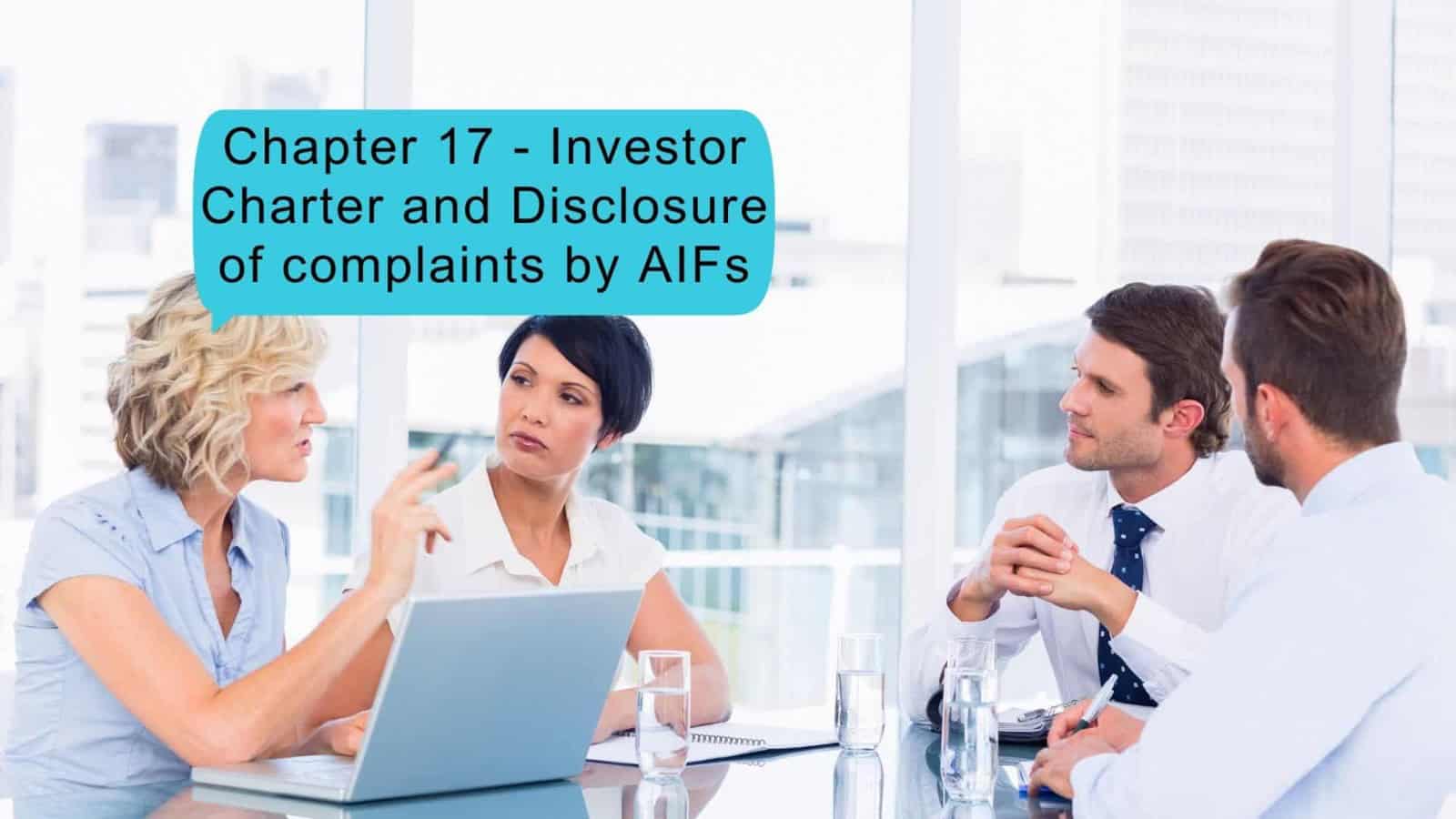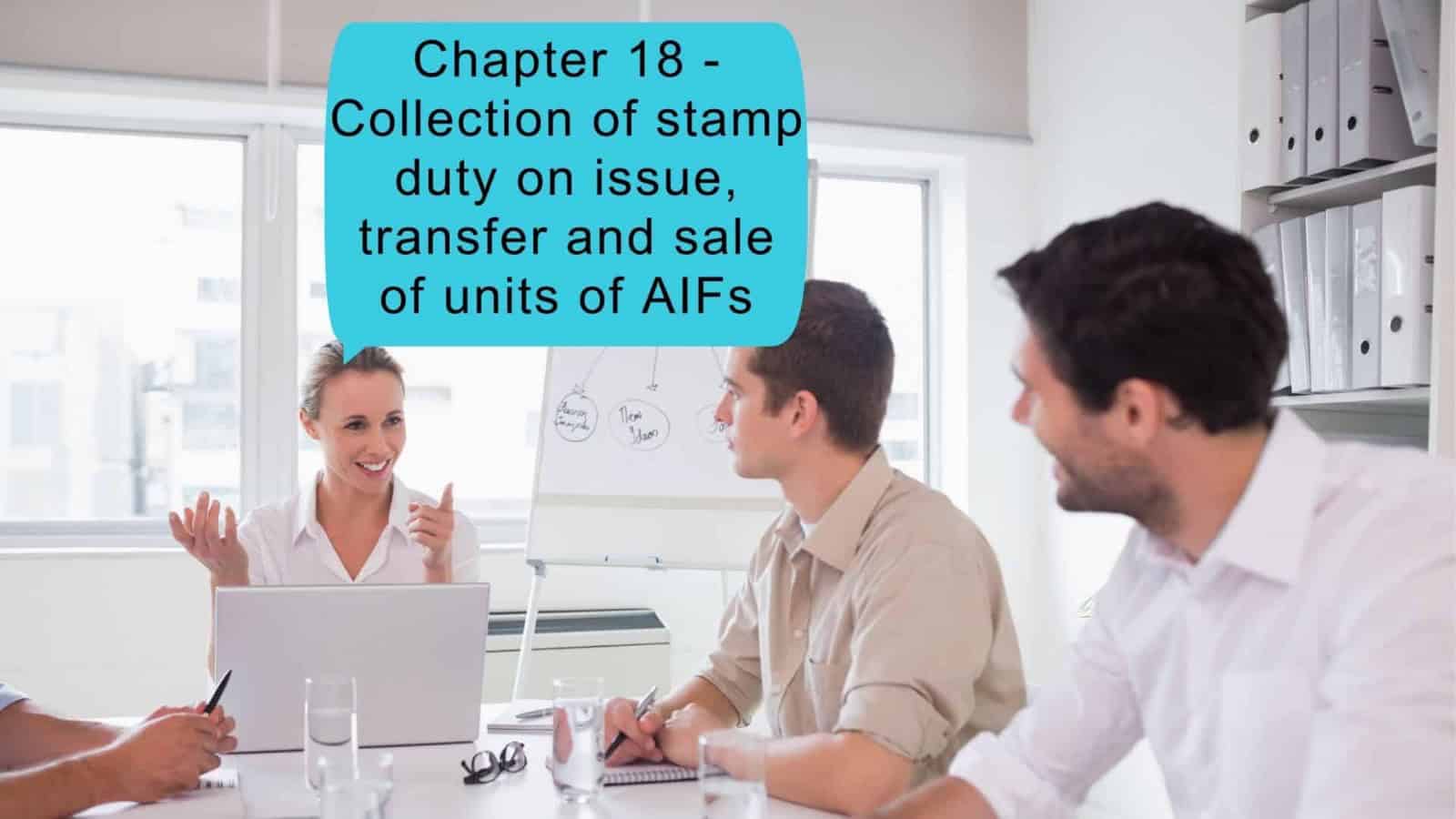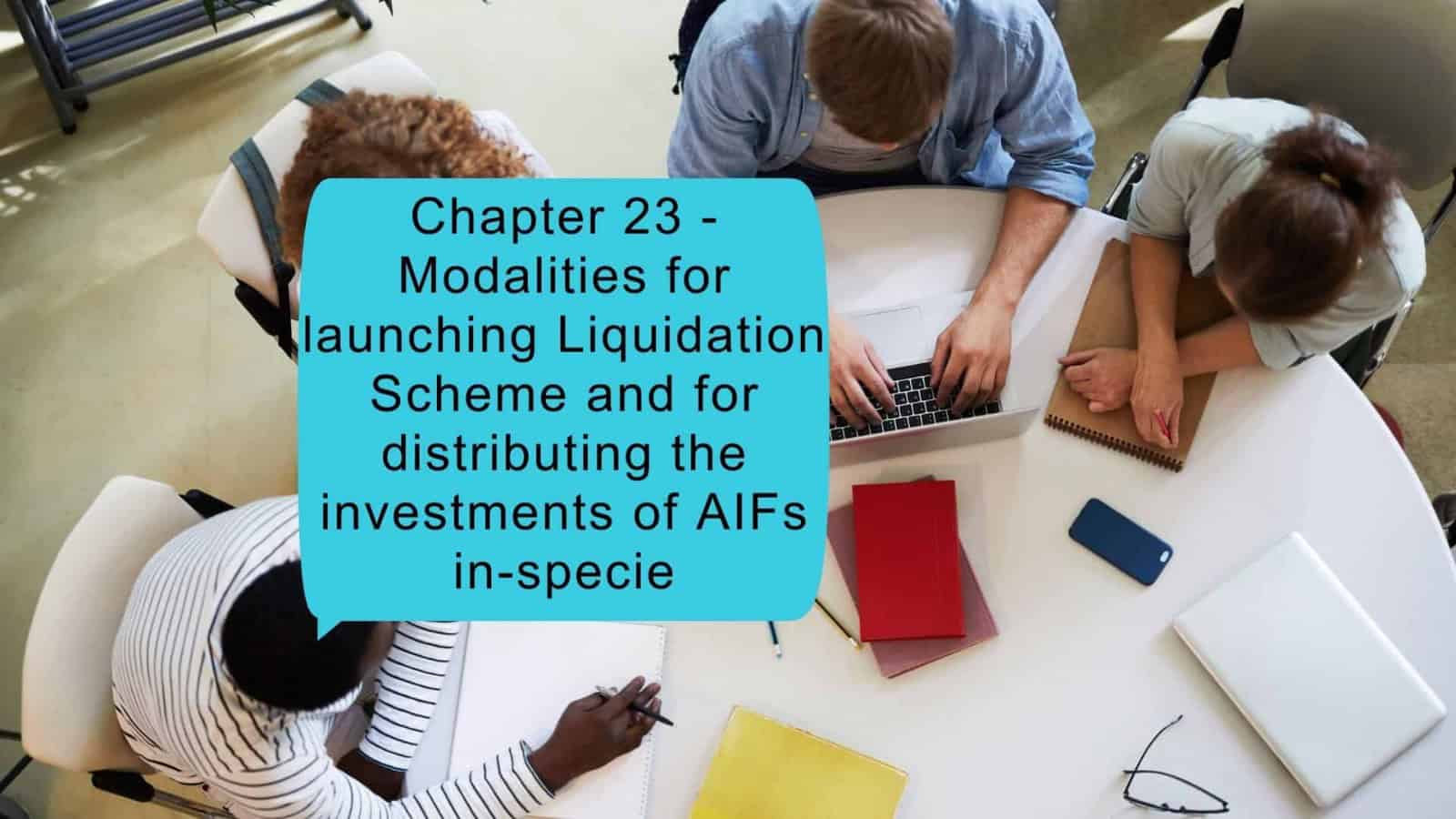Full News

Here's the comprehensive breakdown of all 25 chapters in SEBI's AIF Master Circular in short, simple, lucid less than 2000 words
Here's the comprehensive breakdown of all 25 chapters in SEBI's AIF Master Circular in short, simple, lucid l…
Here you'll read the key takeaways from 25 Chapter long SEBI's comprehensive AIFs master circular in simple, lucid language. SEBI's this new circular replaces all previous ones issued up until March 31, 2024, giving you a streamlined regulatory framework. And this article gives you gist of all 25 chapters in the master circular in less than 2000 words You'll read about AIF registration, investment conditions, investment restrictions, general obligations, reporting requirements, disclosure requirements, co-investments, sponsor's and manager's role, fees and expenses, transparency requirements, investor protection measures, compliance requirements, risk management, conflicts of interest management, rules for outsourcing, grievance redressal, digital payments, rules for data access, accredited investors, benchmarking agencies, performance reporting, audit requirements, valuation rules, taxation rules, liquidation process, non-compliance penalties, and a few miscellaneous relevant provisions
Here're Chapterwise Keytakeaways:

- SEBI has launched an online filing system for Alternative Investment Funds (AIFs) to streamline registration and reporting processes.
- The system aims to enhance transparency, efficiency, and compliance with regulations.
- AIFs can now submit applications, file reports, and access regulatory updates through a centralized platform.
- The online system promotes a robust and well-governed investment ecosystem, fostering investor confidence.
(Click me for reading commentary on chapter 1)

- AIFs must use a prescribed template for PPMs, consisting of Part A for minimum disclosures and Part B for supplementary information.
- PPMs must be filed with SEBI through a registered Merchant Banker, who provides a due diligence certificate.
- The First Close of a scheme must be declared within 12 months of SEBI's communication for taking the PPM on record.
- AIFs must conduct an annual audit of compliance with PPM terms, except for specific exemptions.
- Changes to PPM terms must be intimated to investors and SEBI within a month of the financial year-end, along with a Merchant Banker's due diligence certificate.
(Click me for reading commentary on chapter 2)

- AIFs must obtain in-principle approval from SEBI and submit required documents within a specified time frame.
- AIFs can apply to change their category, subject to certain conditions and fees.
- The process for changing an AIF's category involves obtaining investor consent, not making new investments, and submitting updated documents to SEBI.
- Specific fees are applicable for applications related to changing an AIF's category.
(Click me for reading commentary on chapter 3)

- Foreign investors must be from countries whose securities regulators have signed the IOSCO Multilateral Memorandum of Understanding or have a bilateral MoU with SEBI.
- AIFs cannot accept investments from individuals or entities on the UN Sanctions List or from countries identified by the FATF as having strategic AML/CFT deficiencies.
- AIFs must ensure that all marketing materials are distributed privately and align with the terms of the Private Placement Memorandum (PPM).
- Contribution agreements with investors must not go beyond the terms of the PPM.
- Joint investors are allowed, subject to meeting the minimum investment requirements.
(Click me for reading commentary on chapter 4)

- Category III AIFs can choose to calculate investment concentration norms based on either investable funds or net asset value (NAV).
- Detailed guidelines are provided for leveraging strategies, including the calculation of leverage ratios and the maximum permissible leverage limit.
- Robust risk management frameworks and independent compliance functions are mandated for AIFs employing leverage.
- Specific norms govern the redemption process for open-ended Category III AIFs, including provisions for suspension of redemptions under exceptional circumstances.
- Breach of corpus guidelines and the subsequent actions required are outlined for open-ended schemes.
(Click me for reading commentary on chapter 5)

- SSFs must maintain a minimum corpus of ₹100 crore.
- Minimum investment thresholds are set at ₹10 crore for general investors, ₹5 crore for accredited investors, and ₹25 lakh for employees or directors of the SSF or its manager.
- SSFs intending to act as resolution applicants under the Insolvency and Bankruptcy Code, 2016 must comply with the eligibility requirements outlined therein.
- Stressed loans acquired by SSFs are subject to a minimum lock-in period of six months, except in cases of recovery from the borrower.
- SSFs acquiring stressed loans must adhere to the same due diligence requirements for investors as those mandated for Asset Reconstruction Companies by the Reserve Bank of India.
(Click me for reading commentary on chapter 6)

- AIFs can invest up to 25% of their investable funds in equity and equity-linked instruments of offshore venture capital undertakings, subject to a combined limit of $1.5 billion.
- Investments are allowed only in companies incorporated in countries whose securities regulators have signed the IOSCO Multilateral Memorandum of Understanding or have a bilateral MoU with SEBI.
- AIFs must comply with Foreign Exchange Management (Overseas Investment) Regulations, 2022, and related RBI directions while making overseas investments.
- SEBI allocates overseas investment limits to AIFs on a first-come, first-served basis, and AIFs have four months to utilize the allocated limits.
- AIFs must report the utilization of overseas limits, divestment details, and any unutilized limits to SEBI within specified timelines.
(Click me for reading commentary on chapter 7)

- AIFs can invest in units of other AIFs without labeling themselves as Fund of AIFs.
- Existing AIFs can simultaneously invest in securities and units of other AIFs with consent from unitholders.
- AIFs must disclose proposed allocation, fees, expenses, and compliance processes in their Private Placement Memorandum (PPM).
- Pooling vehicles solely for investing in an AIF must be registered with SEBI as AIFs.
(Click me for reading commentary on chapter 8)

- Category I and II AIFs can buy CDS only for hedging underlying debt investments.
- Category III AIFs can buy CDS for hedging or other purposes within permissible leverage limits.
- Category III AIFs can sell CDS within leverage limits or by earmarking unencumbered government securities.
- Total exposure to an investee company, including through CDS, must comply with concentration norms.
- AIFs must report CDS transactions to custodians and maintain compliance with leverage and disclosure requirements.
(Click me for reading commentary on chapter 9)

- AIFs must conduct at least 10% of their monthly corporate bond trades on the RFQ platform.
- Transactions between AIFs on the RFQ platform must be executed in 'one-to-one' mode.
- The new guidelines aim to enhance transparency and promote fair trading practices in the corporate bond market.
- SEBI's move is part of its ongoing efforts to strengthen the regulatory framework for AIFs and protect investor interests.
(Click me for reading commentary on chapter 10)

- AIFs are subject to investment restrictions and borrowing limits to manage risk exposure.
- Strict conflict of interest policies and procedures are mandated to protect investor interests.
- Transparency and disclosure requirements promote accountability and informed decision-making.
- Regular reporting obligations ensure regulatory oversight and monitoring of AIF activities.
- Comprehensive guidelines aim to foster a fair, ethical, and well-regulated AIF ecosystem.
(Click me for reading commentary on chapter 11)

- Introduces the concept of "Accredited Investors" (AIs) in the Indian securities market
- Defines eligibility criteria based on income and net worth thresholds
- Outlines the accreditation process and responsibilities of Accreditation Agencies
- Allows AIs to access investment products with regulatory concessions or lower ticket sizes
- Provides guidelines for investment service providers to onboard and engage with AIs
- Establishes validity periods for accreditation certificates based on financial information
- Offers flexibility for AIs to withdraw consent and discontinue accreditation benefits
(Click me for reading commentary on chapter 12)

- AIFs must designate a Compliance Officer responsible for monitoring adherence to regulations and circulars.
- Managers must appoint registered custodians for safekeeping of securities and establish written policies to mitigate conflicts of interest.
- Transparency is paramount, with AIFs required to disclose financial, risk management, operational, portfolio, and transactional information to investors.
- AIFs must implement the Stewardship Code for investments in listed equities, promoting active engagement and responsible governance.
- Comprehensive policies and procedures are essential to ensure compliance with regulations, placement memorandums, and investor agreements.
(Click me for reading commentary on chapter 13)

- AIFs have the option to constitute an Investment Committee to approve investment decisions, subject to SEBI's conditions.
- Investor consent is required for appointing external members not disclosed in the Private Placement Memorandum (PPM) or agreement.
- Clarification is pending from SEBI regarding the inclusion of non-resident external members in Investment Committees with approval authority.
- Interim guidelines are provided for processing applications involving Investment Committees with resident and non-resident external members.
(Click me for reading commentary on chapter 14)

- AIFs have the option to constitute an Investment Committee to approve investment decisions, subject to SEBI's conditions.
- Investor consent is required for appointing external members not disclosed in the Private Placement Memorandum (PPM) or agreement.
- Clarification is pending from SEBI regarding the inclusion of non-resident external members in Investment Committees with approval authority.
- Interim guidelines are provided for processing applications involving Investment Committees with resident and non-resident external members.
(Click me for reading commentary on chapter 15)

- SEBI has mandated performance benchmarking for AIFs to promote transparency and facilitate performance comparison.
- AIFs are required to report their performance data to designated Benchmarking Agencies.
- Industry-wide benchmarks will be established for different categories of AIFs (Category I, II, and III).
- Customized performance reports can be generated based on specific investment strategies and criteria.
- AIFs must disclose their performance versus benchmark reports in marketing materials and investor communications.
(Click me for reading commentary on chapter 16)

- AIFs must disclose the Investor Charter in their PPM to inform investors about services, grievance redressal mechanisms, and responsibilities.
- AIFs must disclose data on investor complaints received and their redressal status as a separate chapter in the PPM.
- AIFs must maintain data on investor complaints and compile it within 7 days from the end of each quarter.
- The disclosure requirements are in addition to existing regulations and circulars on investor grievance handling mechanisms.
(Click me for reading commentary on chapter 17)

- AIFs must collect stamp duty on the issue, transfer, and sale of their units as per the Indian Stamp Act, 1899.
- Registered Transfer Agents (RTAs) appointed by AIFs will act as collecting agents for stamp duty.
- For transactions through recognized stock exchanges or depositories, the respective exchange/clearing corporation or depository is empowered to collect stamp duty.
- The directive ensures compliance with stamp duty regulations for AIF unit transactions, promoting transparency and uniformity.
(Click me for reading commentary on chapter 18)

- AIFs must obtain prior approval from SEBI for any change in control of the sponsor/manager or change in the sponsor/manager itself.
- A fee equivalent to the registration fee for the AIF's category/sub-category must be paid for such changes.
- The fee is not applicable in certain cases, such as when the manager acquires control of the sponsor or when a sponsor exits in a multi-sponsor AIF.
- The approval process includes provisions for dissenting investors to exit the AIF under specific circumstances.
(Click me for reading commentary on chapter 19)

- AIFs must issue units in dematerialized form and credit them directly to investors' demat accounts.
- Existing units must be dematerialized by October 31, 2023 (for AIFs with corpus > INR 500 crore) or April 30, 2024 (for AIFs with corpus < INR 500 crore).
- Units of investors who have not provided demat account details will be temporarily held in an "Aggregate Escrow Demat Account" until the details are provided.
- Depositories have been directed to facilitate the dematerialization process and ensure compliance with AIF regulations.
(Click me for reading commentary on chapter 20)

- AIFs must hold all new investments made on or after October 1, 2024, in dematerialized form.
- The dematerialization requirement applies to investments made directly in investee companies or acquired from other entities.
- The regulation aims to enhance transparency, investor protection, and operational efficiency in the AIF industry.
- Depositories have been directed to facilitate the dematerialization process and ensure compliance with AIF regulations.
(Click me for reading commentary on chapter 21)

- AIFs must follow prescribed valuation norms for securities covered under SEBI (Mutual Funds) Regulations.
- For other securities, valuation guidelines endorsed by eligible AIF industry associations must be followed.
- Managers are responsible for ensuring fair valuation and appointing independent valuers who meet specified criteria.
- Significant deviations in valuations must be disclosed to investors, along with the rationale.
- AIFs must report audited valuation data to performance benchmarking agencies within stipulated timelines.
(Click me for reading commentary on chapter 22)

- AIFs can launch Liquidation Schemes to sell unliquidated investments from expired schemes.
- AIFs can distribute unliquidated investments in-specie to investors upon scheme expiry.
- Consent of 75% investors by value is required for both Liquidation Schemes and in-specie distribution.
- AIFs must arrange bids for at least 25% of unliquidated investments' value and disclose valuations.
- Dissenting investors have the option to exit using the arranged bids.
- Specific valuation and reporting requirements ensure transparency and accurate performance tracking.
(Click me for reading commentary on chapter 23)

- AIFs can excuse investors from participating in an investment if their participation would violate applicable laws or regulations, or contravene the investor's internal policies.
- AIFs can exclude investors if their participation could lead to regulatory violations or have a material adverse effect on the fund.
- Clear procedures must be established for excusing or excluding investors, including documenting the rationale and supporting evidence.
- Partial exclusion or excuse is permitted for investors who are AIFs or investment vehicles, based on the underlying investors' eligibility.
- The guidelines promote transparency, compliance, and effective risk management for AIFs.
(Click me for reading commentary on chapter 24)

- AIFs are required to offer a 'Direct Plan' option for their schemes, which will not involve any distribution fee or placement fee.
- Investors approaching AIFs through SEBI-registered intermediaries charging separate fees must be on-boarded via the Direct Plan.
- Category III AIFs can only charge distribution/placement fees on an equal trail basis, with no upfront fees allowed.
- Any distribution/placement fees charged by Category III AIFs must be paid from the management fees received by the managers.
- These guidelines aim to provide investors with greater transparency, flexibility, and protection against mis-selling practices.
(Click me for reading commentary on chapter 25)




